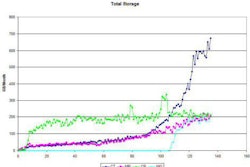While radiologists tend to assess PACS by evaluating its efficiency and productivity, clinicians are inclined to appraise PACS based on their intensity of use and perception of the system's usefulness, according to researchers from the HEC University of Montreal in Quebec.
Using models and tools commonly used to assess implementation success in the information technology world, the institution sought to present a more integrated view and a comprehensive framework of assessing PACS success than previous methods, performed from a user's perspective, according to Dr. Luigi Lepanto. He presented his institution's experience during the annual meeting of the Society for Imaging Informatics in Medicine (SIIM) in Providence, RI, earlier this month.
Two years after the university installed a PACS network, the researchers surveyed radiologists and clinicians regarding their experiences with the software. The questionnaire covered eight topics, including system quality, information and image quality, service quality, system use (intensity, frequency, and scope), user satisfaction, perceived net benefits, confirmed expectations, and system continuance intention. System quality was assessed using seven variables, including ease of use, usefulness, integration, reliability, ease of access, interface quality, and response speed.
Most of the questions employed the seven-point Likert scale, while some required quantitative responses. After the radiologists and clinicians were surveyed, the data obtained from both groups were compared using the Mann-Whitney U-test. The researchers also performed linear regression analyses to identify elements influencing satisfaction and perceived net benefits.
Of the 47 radiologists surveyed, 24 (51%) responded, while 131 of the 649 (20%) clinicians responded. Radiologists used the PACS network a mean of 25.5 hours a week, compared with 5.6 hours for clinicians, Lepanto said.
As for ease of use, radiologists gave the PACS network an average grade of 5.5 out of 7, compared with 5.1 by the clinicians. Radiologists ranked the usefulness of the PACS at 4.8, compared with 4.7 by the clinicians.
Both groups of respondents found the PACS to be poorly integrated with other information systems, however, with integration rated 2.8 out of 7 by radiologists and 3.3 by clinicians, according to Lepanto. Since the survey, however, bidirectional RIS/PACS integration has been added at the client level for radiologists, he noted. Clinicians had a different integration problem, with the lack of a portal to other information systems, he said.
PACS reliability was rated higher by radiologists (5.6/7) than clinicians (4.9/7); this could also be due to the use of different applications by the two groups, Lepanto said.
Information quality was rated high by both radiologists (5.3/7) and clinicians (5.2/7), as was image quality (5.8/7 for radiologists and 5.0/7 for clinicians).
From a statistical analysis, user satisfaction with the PACS software for radiologists was most significantly related to ease of use and reliability, Lepanto said. For clinicians, satisfaction was more significantly associated with usefulness and confirmed expectations.
Radiologists' assessment of PACS seems to depend more on issues of efficiency and productivity (i.e., ease of use and reliability), according to Lepanto.
"Many attributes of PACS such as image quality, system integration, and interface quality did not impact user satisfaction," he said. "Although they judged the system integration to be insufficient, it wasn't enough for them to say PACS was not a successful application. Also, image quality may no longer be an issue."
Clinicians, on the other hand, were influenced by the intensity of use and usefulness of the system, Lepanto said.
Lepanto also noted that 90% of respondents had no previous PACS experience and that expectations may change over time.
The proposed IT model offered a multidimensional assessment of PACS success, and may be useful for other IT projects, Lepanto concluded.
"The results are specific to our implementation and may differ in other settings, but the model can aid in identifying determinants of success, which over time have proved to be interesting issues, as they have evolved as PACS has evolved," he said.
By Erik L. Ridley
AuntMinnie.com staff writer
June 27, 2007
Related Reading
Multitier staffing model optimizes imaging IT support capabilities, June 9, 2007
When the OR and radiology collide, workflow solutions are needed, June 8, 2007
Imaging informatics shaped by evolving role, June 7, 2007
PACS administrator certification program gets under way, May 30, 2007
Vigilance key to managing risk in the digital world, May 15, 2007
Copyright © 2007 AuntMinnie.com




















